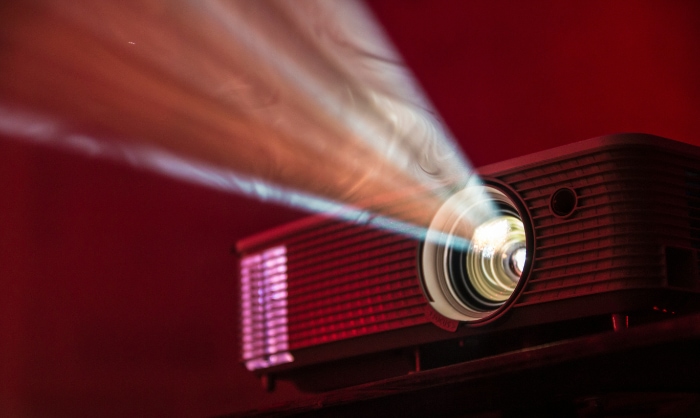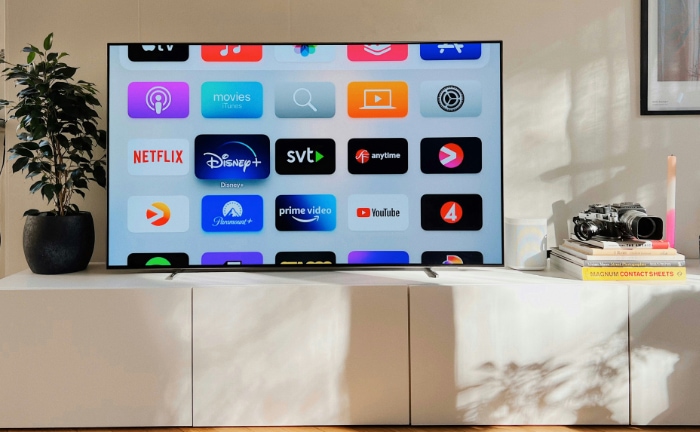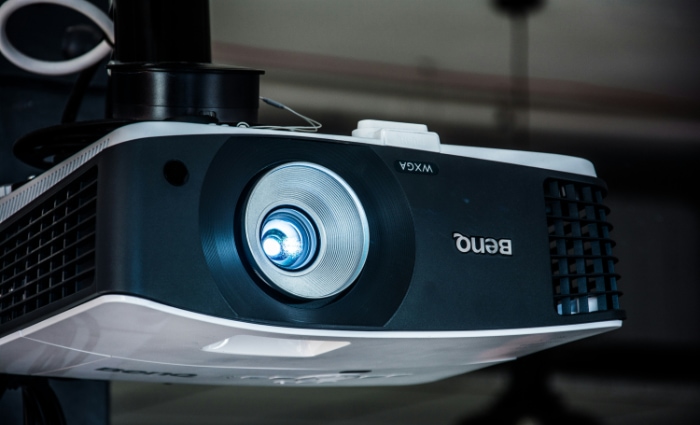Projector vs. OLED TV: Sizing Up Your Cinema Space

Crafting a cozy home theater setup has become more than just a trend; it’s a pursuit of cinematic bliss right in the comfort of our living rooms. This quest often leads to a critical decision point: the choice between the immersive vastness of a projector or the stunning clarity of an OLED TV.
Each option offers a unique avenue for movie enthusiasts to bring the magic of cinema home, but the decision isn’t always straightforward. From whispered debates in electronics aisles to animated discussions in online forums, the projector versus OLED TV debate continues to capture imaginations.
Display Technology
When setting up a home theater, the display technology behind your screen plays a crucial role in how you’ll experience your favorite movies. Whether it’s the vast canvas of a projector or the sharp, vivid display of an OLED TV, understanding the mechanics behind each option can help you make an informed decision.
Projectors
Projectors work by casting images onto a surface, usually a screen designed for this purpose. They come in various types, but the most common ones you’ll encounter are DLP (Digital Light Processing), LCD (Liquid Crystal Display), and LCoS (Liquid Crystal on Silicon).
DLP (Digital Light Processing)
DLP projectors use tiny mirrors to reflect light toward the screen. One key advantage is their sharp image quality and reliability. However, some users notice a “rainbow effect,” a brief flash of rainbow colors.
LCD (Liquid Crystal Display)
Unlike DLP projectors, LCD versions pass light through liquid crystal panels to create the image. This technology is known for producing bright, colorful images. However, LCD projectors can be bulkier and may suffer from image degradation over time due to light exposure.
LCoS (Liquid Crystal on Silicon)
LCoS combines features of DLP and LCD, using liquid crystal on a silicon backplate. This technology offers high-resolution images with excellent color accuracy but comes at a higher cost and often requires a darker room for optimal viewing.
OLED TVs
OLED (Organic Light-Emitting Diode) TVs represent a leap in screen technology. In an OLED TV, each pixel emits its own light, allowing for true blacks and outstanding contrast ratios.
Self-Illuminating Pixels
The ability of each pixel to produce light independently eliminates the need for a backlight. This leads to better viewing angles, deeper blacks, and a more vibrant color spectrum compared to traditional LED/LCD TVs.
Slim Design and Efficiency
OLED technology allows for thinner, more energy-efficient screens that offer superior image quality. Despite their thin profile, OLED TVs can display fast-moving images smoothly, making them ideal for action-packed movies or sports.
Picture Quality
The heart of a home theater system beats with its picture quality. This factor dramatically influences how we feel about what we’re watching, from the depths of space in a sci-fi epic to the vibrant landscapes of a nature documentary.
The technologies behind projectors and OLED TVs take different approaches to color accuracy and contrast, as well as how they handle various lighting conditions in your viewing environment.
Color Accuracy and Contrast
Projectors can deliver stunning visuals, especially in controlled lighting conditions. The accuracy of colors with high-quality projectors can be excellent, but it often depends on the surface they’re projecting onto.
A dedicated, high-quality screen is crucial for the best performance. When it comes to contrast, projectors may struggle to achieve true blacks, as the darkest area of the image can only be as black as the screen or wall it’s projected onto, which might actually be a dark gray.
OLED technology, by its nature, excels in color accuracy and contrast. Since each pixel emits its own light and can be turned off completely, OLED TVs can achieve perfect blacks and infinite contrast ratios.
This capability translates into exceptionally vivid and lifelike images, making OLED TVs a top choice for those who prioritize picture quality.
Brightness and Viewing Environment
The impact of ambient light on a projector’s image is significant. Even the most advanced projectors can struggle in brightly lit rooms, leading to washed-out images.
The best projector experiences are often found in darkened rooms, where the technology can shine without competing with external light sources. This makes projectors ideal for dedicated home theater rooms where you can control the lighting.
OLED TVs maintain excellent picture quality even in well-lit environments. Thanks to their ability to produce intense brightness while also delivering deep blacks, OLED TVs offer a consistent viewing experience throughout the day.
However, in extremely bright conditions, even OLED screens can suffer from glare, though to a lesser extent than many of their counterparts.
Screen Size and Viewing Distance

Choosing the right screen size and determining the optimal viewing distance are critical factors that enhance the immersive experience of a home theater. The nature of projectors versus OLED TVs brings into play different considerations for these aspects, influencing how viewers can expect to engage with content, from blockbuster movies to gripping documentaries.
Projectors
Projectors offer unparalleled flexibility in screen size, making them a popular choice for those who dream of a cinema-scale viewing experience at home. Unlike fixed-size TVs, the size of the image a projector throws can be adjusted by changing the distance between the projector and the screen.
This adaptability allows for a range from modestly sized images suitable for small rooms to expansive displays that fill a wall, providing a genuine theater feel.
Impact on Viewing Distance
The flexibility in screen size also affects the required viewing distance. Generally, the larger the image, the farther back viewers should sit to appreciate the full scope without having to move their heads.
There’s a simple formula often used to calculate this: for every 10 inches of screen diagonal, the seat should be positioned approximately 1.5 to 2.5 times that distance away from the screen. For example, for a 100-inch screen, the optimal viewing distance would be between 12.5 to 20.8 feet.
This guideline ensures viewers can enjoy a large, engaging picture without straining their eyes or missing details.
OLED TVs
OLED TVs are celebrated for their sharp, vibrant displays, available in a variety of sizes to fit different spaces and preferences. While not as large as the images projectors can create, OLED TVs offer screen sizes that cater to a wide range of home theater setups, from compact 55-inch models to impressive 77-inch or even larger screens.
Standard Sizes and Optimal Viewing Distances
The common sizes for OLED TVs typically range from 55 inches to 77 inches, with some brands offering sizes up to 88 inches. The recommended viewing distance for these TVs follows a similar guideline to projectors but is slightly more flexible due to the higher resolution and pixel density of OLED displays.
A good rule of thumb is to sit at a distance that is 1 to 1.5 times the screen’s diagonal measurement. For a 65-inch OLED TV, this translates to a viewing distance of about 5.4 to 8.1 feet.
This range ensures a comfortable view of the screen without pixelation, allowing viewers to take in all the details and rich colors OLED technology provides.
Installation and Setup
Crafting the perfect home theater involves more than just choosing between a projector and an OLED TV; it also requires careful consideration of installation requirements and setup complexities. This step is crucial in transforming your space into a haven for movie lovers.
Space Requirements and Flexibility
Projectors demand a bit more planning and space to accommodate their setup compared to TVs. You’ll need a clear path between the projector and the screen without any obstructions to avoid casting shadows.
The required distance to achieve your desired screen size, known as the throw distance, varies between models. Short-throw projectors can project a large image from a shorter distance, making them suitable for smaller spaces.
Installation might also involve mounting the projector on the ceiling for a permanent setup, which can add to the complexity but offers a clean, unobtrusive look.
OLED TVs are simpler to install. They don’t require the calculation for throw distance or worry about obstructions between the screen and the viewer.
These TVs can be mounted on a wall or placed on a stand, fitting easily into most living spaces regardless of size. The sleek design of OLED TVs complements modern decor and saves space, offering flexibility in positioning without compromising on the viewing experience.
Connectivity and Smart Features
Modern projectors come equipped with a variety of connectivity options, including HDMI, USB, and sometimes wireless connections like Wi-Fi and Bluetooth. This allows for easy pairing with devices such as gaming consoles, streaming sticks, and computers.
However, projectors may lack the built-in smart platform found in many TVs. While some high-end projectors include smart features, often an external device is needed to stream content from Netflix, YouTube, and other services.
OLED TVs excel in the realm of connectivity and smart features. Most models come with a built-in smart platform, offering direct access to a plethora of streaming services without the need for additional devices.
They also include multiple HDMI ports, USB connections, and often wireless connectivity options like Wi-Fi and Bluetooth. This integration makes OLED TVs a more convenient choice for users who value seamless access to their favorite digital content.
Cost and Longevity

Investing in a home theater system is not just about achieving the best audiovisual experience; it’s also about understanding the financial implications and the expected lifespan of your equipment. Whether you’re leaning towards a projector or an OLED TV, considering the initial investment, running costs, durability, and longevity is essential.
Initial Investment and Running Costs
The upfront cost of projectors can vary widely, from relatively affordable options suitable for casual viewing to high-end models for the dedicated enthusiast. In general, projectors can be more budget-friendly at the outset, especially when comparing models that produce a similar screen size to large OLED TVs.
However, projectors have additional costs to consider, such as the screen (if you choose to buy one), replacement bulbs for lamp-based models, and potentially higher installation expenses. Energy consumption depends on the projector type but is generally comparable to that of a traditional TV.
OLED TVs tend to have a higher initial price, especially as screen size increases. The price reflects the technology’s superior picture quality and built-in smart features.
OLED TVs are virtually maintenance-free, with no bulbs to replace, contributing to lower ongoing costs. They are also energy-efficient, although the exact consumption will depend on the screen size and usage patterns.
Durability and Lifespan
Projectors, especially lamp-based models, may require bulb replacements after 2,000 to 5,000 hours of use, affecting their long-term cost and convenience. LED and laser projectors offer longer lifespans, with some models boasting up to 20,000 hours of viewing time before the light source begins to dim. The mechanical parts of a projector, like the fan, may also need maintenance or replacement over time.
OLED TVs are known for their durability and have a typical lifespan of around 100,000 hours before brightness begins to decrease. One potential issue with OLED technology is burn-in, where static images can leave a permanent mark on the screen if displayed too long.
However, this is less of a concern with newer models and with typical home viewing patterns. OLED TVs, therefore, offer a solid combination of longevity and low maintenance, making them a worthwhile investment for many users.
Conclusion
Crafting the perfect home theater setup involves a delicate balance of technology, budget, and personal preference. From the expansive, cinema-like experience offered by projectors to the crisp, detailed imagery of OLED TVs, the choice carries significant implications for your viewing enjoyment.
Projectors shine in their ability to create massive screens for the ultimate movie night, adaptable to your space but requiring a bit more setup and consideration for ambient light. On the other hand, OLED TVs offer unparalleled ease of use, vibrant colors, and deep contrasts right out of the box, suited for varied lighting conditions and requiring minimal maintenance.
As technology continues to evolve, so too will the options for home theaters. Yet, the goal remains the same: to bring the magic of cinema into our homes.
Whichever path you choose, ensure it aligns with your vision of the perfect home theater, blending technology with the personal touch that turns a house into a home.


